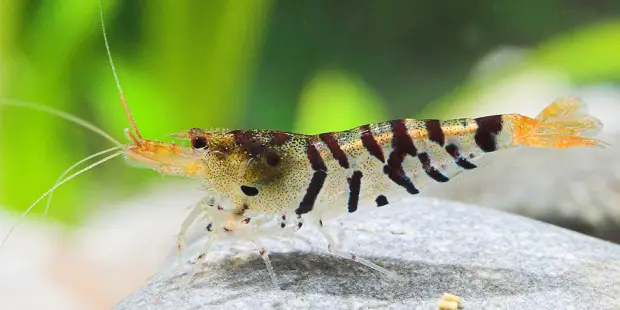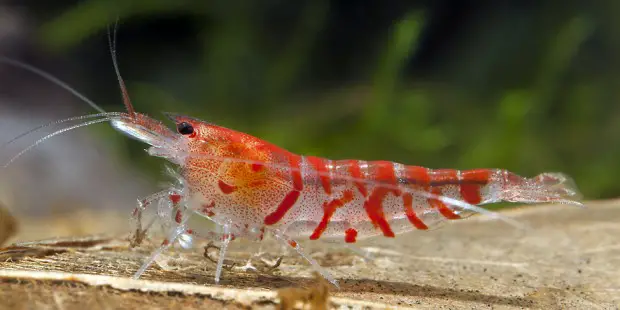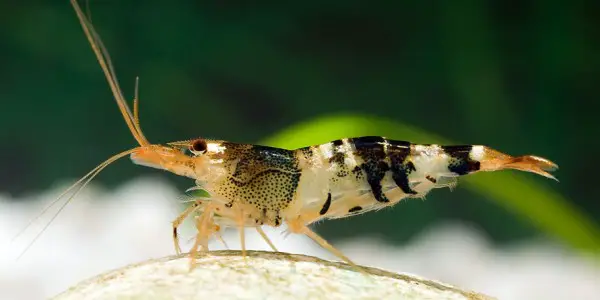New shrimp from Hong Kong and southern China

Live female of C. mariae collected in a swampy area near Conghua City, Guangdong province, China. © Werner Klotz
The freshwater atyid genus Caridina contains a number of species which have become popular ornamental pets on a global scale over the last couple of decades, but the identities of two of the most familiar are only now being resolved…
The ubiquitous ‘tiger’ and ‘bee’ shrimp have typically been considered to represent phenotypic variants of a single species, C. cantonensis, or referred to as C. cf. cantonensis, in the aquarium hobby. More recently, Wang et al. (2008) concluded that their new species C. maculata and C. venusta together represent the ornamental bee shrimp, but new research by German team Werner Klotz and Thomas von Rintelen suggests otherwise. Their study, published in a recent issue of the journal ‘Zootaxa’, comprises a taxonomic revision and molecular phylogenetic analysis of Caridina species native to Guangdong province, southern China, and Hong Kong Special Administrative Region.
The tiger shrimp has been named Caridina mariae Klotz & von Rintelen 2014, and can be distinguished from congeners by its striking colour pattern which consists of a semi-transparent body with a dark brown to blackish blotch on the lower portion of the carapace, a series of similarly-coloured stripes on the posterior part of the carapace and first six abdominal segments, and a lack of dark markings on the tail fan.
C. mariae is named in honour of the first author’s wife, Maria, for “her support during several field trips and her abundant patience when the first author is spending most evenings behind the microscope”.

Red colour mutation occurring in an aquarium population of C. mariae originating from the swampy area near Conghua City. © Werner Klotz
It is currently known from two localities in the neighbouring counties of Yingde and Conghua, Guangdong province, southern China, but can be found elsewhere in the region according to local fishermen. One of these habitats comprises a small hill stream, and the other a swampy area with a pH of 7.0 and conductivity 40 μS. In the latter C. mariae occurs sympatrically with C. cantonensis and a second new species, C. conghuensis Klotz & von Rintelen 2014, which is named for the type locality near Conghua and can be identified by its dark blue to blackish body with a few weak white stripes on the rostrum, abdominal segments, and tail fan.
There are also various morphological differences between all of these taxa in addition to their characteristic colour patterns.
The third new species, Caridina logemanni Klotz & von Rintelen 2014, appears to closely resemble the original aquarium bee shrimp. It is known only from three small hill streams in the New Territories region of Hong Kong where it was collected among leaf litter and between boulders in shallow water with pH 6.0, conductivity 33 μS, dissolved oxygen 8.1 mg/l, and temperature 19.8 °C. No other shrimp species have been collected from these streams, but large populations of the more widely-distributed C. cantonensis occurs in neighbouring drainages. Although closely related these two species exhibit significant differences in live colouration, with C. logemanni possessing a series of large, brown to blackish markings on the carapace and abdominal segments, whereas C. cantonensis possesses numerous small spots but is otherwise relatively plain.
The new species is named in honour of German aquarists Carsten and Frank Logemann, “for their long lasting work on bee shrimp as aquarium pets and their support of our research in Hong Kong”.
The story does not end with the three new species, however, because the paper also revisits the study published by Wang et al. (2008), who described four new Caridina species; C. maculata, C. venusta, C. tumida, and C. meridionalis. Of these, C. maculata and C. venusta were depicted as possessing a colour pattern comprising alternating light and dark bands, and the authors assumed them to be the ornamental species exported to Japan and Singapore as bee shrimp. This opinion has not been widely followed in the aquarium hobby, however.
All four species were collected in Yingde County, close to the type locality of C. mariae, and their habitats were visited and collections made during fieldwork for the new study. Based on this material, Klotz and von Rintelen concluded that the image of live C. maculata in Wang et al. actually depicts C. venusta, and that the image of C. tumida is in fact a specimen of C. maculata. In addition, they found no significant morphological differences between different populations of C. tumida and C. venusta, thus the former becomes a junior synonym of the latter. C. maculata was found to be variable in terms of colour pattern; most populations possess relatively reduced dark bands on the carapace and abdominal segments, with the exception of one form which occurs sympatrically with C. venusta at its type locality and has wide reddish bands. In C. meridionalis, which also possesses alternating light and dark bands, the first pereiopod lacks an arthrobranch, thus it is moved into the genus Paracaridina and synonymised with P. zijinica Liang, 2002, with which it is identical.
Another species with a banded colour pattern from the region is C. trifasciata Yam & Cai, 2003, which occurs in Sai Kung district in Hong Kong and on Hengqin Island in Guangdong. While populations from Hong Kong possess very narrow dark bands on the body, specimens from Hengqin have thicker, bluish bands.
All five samples from ornamental bee shrimp strains grouped together with C. cantonensis in the phylogenetic analyses, suggesting that it is the genuine ancestor of line-bred aquarium forms such as the ‘crystal red’, ‘King Kong’, or ‘blue bolt’ despite lacking a banded colour pattern. A single aquarium specimen with morphology identical to C. logemanni also clustered together with C. cantonensis, which is a possible indicator of hybridisation with captive lineages in this pair of sister species. In addition, C. logemanni, C. venusta, and some other species mentioned here have appeared in the ornamental trade, the former sometimes referred to as ‘Hong Kong diamond bee shrimp’, although other names may have been used as well.
Several species may therefore be referred to as bee shrimp in the aquarium hobby, although if you are purchasing captive-bred stock, especially the ornamental varieties, then your shrimp are likely to resemble C. cantonensis in a genetic sense. The presence of several, similar-looking species in southern China and Hong Kong suggests that hybridisation cannot be ruled out, however.
For further information see the full paper: Klotz, W., & T. von Rintelen, 2014. To “bee” or not to be – on some ornamental shrimp from Guangdong Province, Southern China and Hong Kong SAR, with descriptions of three new species. Zootaxa 3889(2): 151-184 (link to abstract only).
Other references:
Cai, Y., & Ng, N. K., 1999. A revision of the Caridina serrata species group, with descriptions of five new species (Crustacea: Decapoda: Caridea: Atyidae). Journal of Natural History 33(11): 1603-1638.
Guo, Z. L., & S. De Grave, 2004. Atyid shrimps of the genus Paracaridina (Crustacea, Decapoda, Atyidae) from Hunan Province, China. Hydrobiologia 513(1-3): 197-204.
Wang, L., X. Liang & F. Li, 2008. Descriptions of four new species of Caridina (Decapoda: Atyidae) from China. Zootaxa 1726: 49–59.
Yam, R. S., & Y. Cai, 2003. Caridina trifasciata, a new species of freshwater shrimp (Decapoda: Atyidae) from Hong Kong. Raffles Bulletin of Zoology 51(2): 277-282.
Thanks to Werner Klotz.
Category: Articles, Freshwater Invertebrates | Tags: bee shrimp, Caridina, tiger shrimp | Comment »




Site improvements
This is an excellent post, glad you shared it. I just stumbled upon your blog and have enjoyed reading your posts.
14th Jan 2025
Site improvements
This is an excellent post, glad you shared it.
14th Jan 2025
Product reviewers wanted
Are you still looking for product reviewers?
19th Dec 2024
Product reviewers wanted
Hey! Interesting article!
17th Dec 2024
Site improvements
Got it! Thanks for the update. It's good to know that Seriously Fish is working on improving the site's performance and addressing the email and forum...
21st Nov 2024